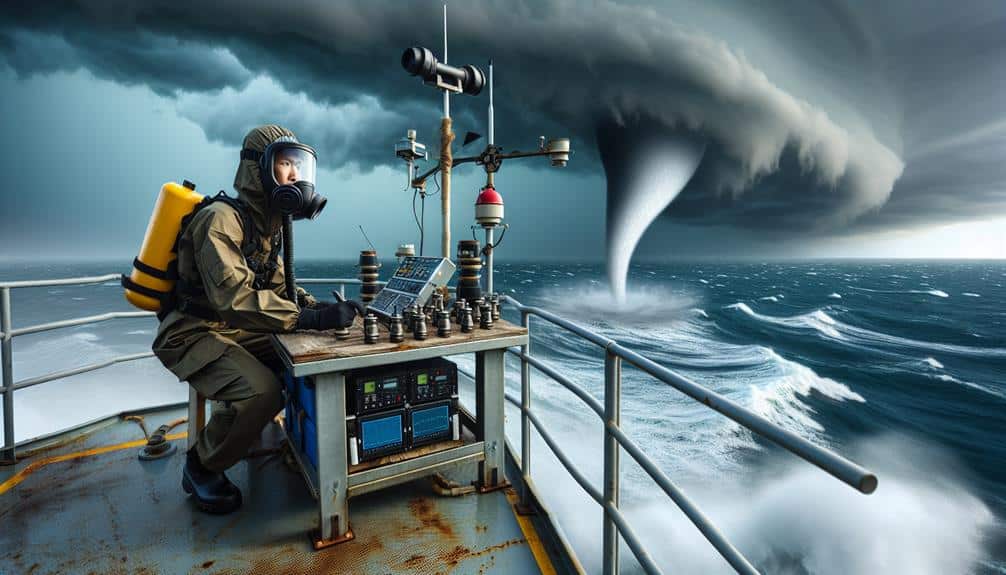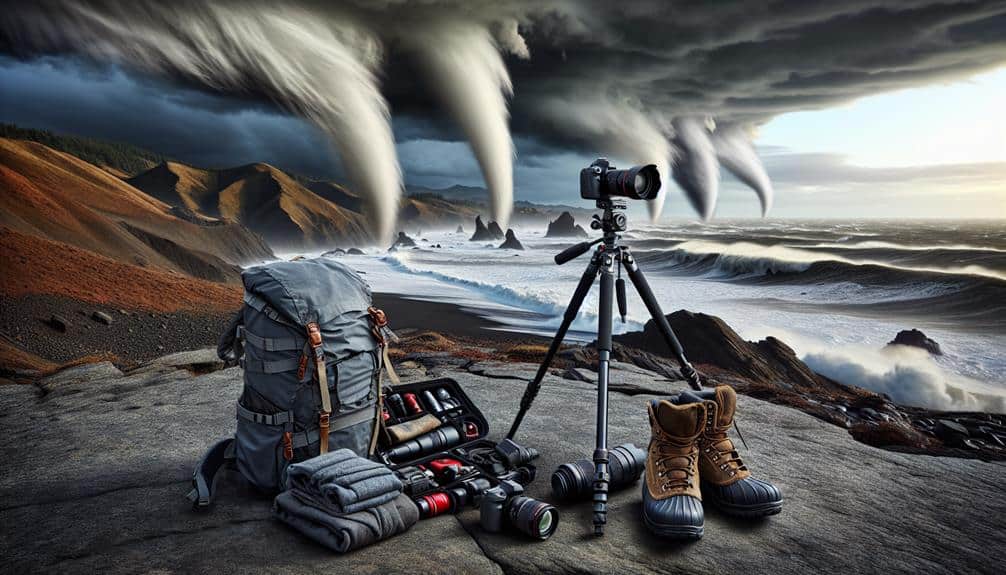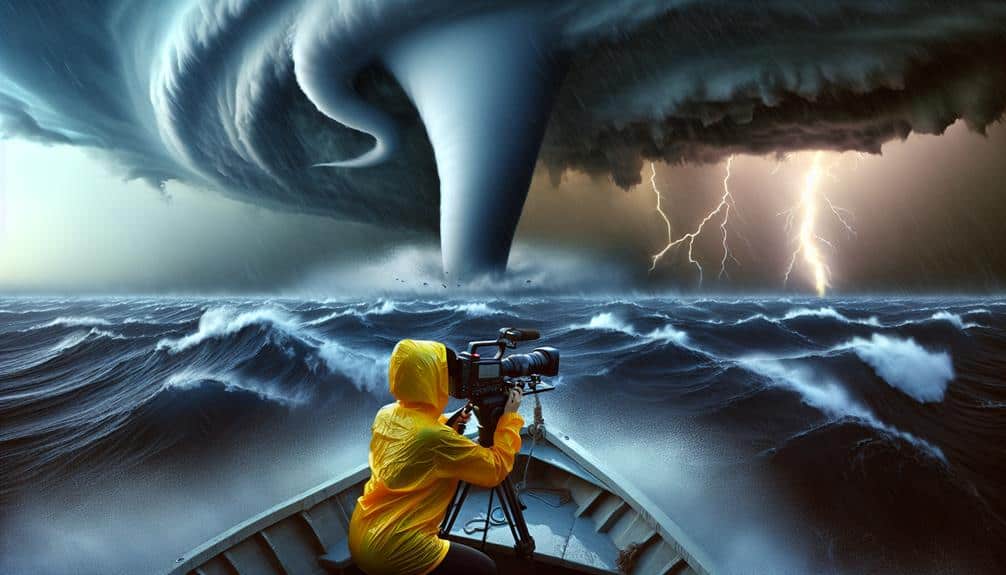In our endeavor to preserve waterspouts and their surrounding ecosystems, we must combine data-driven insights with practical gear and safety measures. We track waterspouts using high-definition radar, GPS, and remote sensing technologies, which help us gather crucial data on their formation and impact. Proper waterproof clothing, boots, and advanced communication devices are essential to guarantee our safety in harsh conditions. We also engage local communities in conservation efforts, emphasizing sustainable practices and policy advocacy. Our holistic approach not only advances scientific understanding but also guarantees the long-term protection of marine biodiversity. Let's immerse ourselves in the intricacies and strategies involved.
Key Points
- Wear high-quality waterproof clothing and boots to prevent hypothermia and ensure safety on slippery surfaces.
- Use advanced GPS devices and traditional maps for accurate tracking and spatial awareness.
- Regularly maintain and store safety gear like life jackets and communication devices to prevent malfunctions.
- Utilize high-definition radar and satellite imagery for real-time weather monitoring and data collection.
Understanding Waterspouts
Understanding waterspouts requires examining their meteorological formation, behavior, and impact on marine ecosystems. When we look at waterspout formation, it starts with a parent cloud, typically a cumulus or cumulonimbus, over a warm body of water. The temperature contrast between the warm water surface and cooler air above creates the necessary instability. As the air rises, it begins to rotate due to wind shear, leading to the formation of a waterspout.
Waterspouts can be classified into two types: fair-weather waterspouts and tornadic waterspouts. The former forms in calm conditions and is generally less intense, while the latter is associated with severe thunderstorms and can be quite destructive.
Despite their mesmerizing appearance, waterspouts have a significant impact on ecosystems. They can transport marine organisms, altering local biodiversity and potentially introducing invasive species to new areas.
Moreover, waterspouts can cause sudden changes in water temperature and salinity, affecting marine life. For instance, they can disrupt the feeding and breeding grounds of fish and other marine animals, leading to long-term ecological consequences.
Essential Gear
As we prepare to chase waterspouts, we must prioritize essential gear for both safety and accuracy in our data collection.
We'll focus on:
- Waterproof clothing essentials,
- Reliable navigation tools, and
Equipping ourselves properly guarantees our research remains rigorous and environmentally responsible.
Waterproof Clothing Essentials
Equipping ourselves with high-quality waterproof clothing is essential for both comfort and safety while monitoring waterspouts in diverse and often unpredictable environments. Rain gear, including a durable waterproof jacket and pants, can protect us from the elements, ensuring we stay dry and warm. According to data from the Environmental Protection Agency, extended exposure to moisture can lead to hypothermia even in milder temperatures, making rain gear a critical investment.
Waterproof boots are another indispensable component of our field attire. They not only keep our feet dry but also provide necessary traction and stability on slippery surfaces. Research from the National Weather Service highlights that proper footwear reduces the risk of falls and injuries by up to 50%.
Our mobility and safety greatly improve when we wear boots designed for wet and rugged terrain.
Reliable navigation tools are essential for guaranteeing we accurately track and study waterspouts in dynamic and often hazardous environments. Our primary navigation techniques should include the use of advanced GPS devices. These tools enable us to pinpoint our exact location and monitor our movements in real-time, a critical aspect when documenting the rapid formation and movement of waterspouts.
Complementing our GPS devices, traditional map reading and compass skills remain important. Maps provide a broader geographical context, enabling us to plan our routes effectively and anticipate potential obstacles. A compass, on the other hand, ensures we can maintain our bearings even when technology fails or in areas where satellite signals are weak.
Data-driven approaches emphasize the integration of these tools. By combining GPS data with physical maps, we enhance our spatial awareness and improve our decision-making processes. For instance, overlaying weather data on our maps can help predict waterspout occurrences more accurately, allowing us to position ourselves efficiently for observation and data collection.
Safety Equipment Checklist
Having established our navigation techniques, we must now make certain we're equipped with the right safety gear to handle the unpredictable conditions of tracking waterspouts.
First, let's talk about equipment maintenance and safety protocols. Regularly check the condition of your gear—life jackets, helmets, and harnesses. Verify they meet the latest safety standards and replace any worn-out items. This isn't just about compliance; it's about our lives.
Next, communication devices are essential. Invest in a reliable VHF radio and a satellite phone. Waterspouts can form rapidly, and having immediate contact with emergency services or fellow conservationists can be life-saving. Test these devices regularly to confirm they function correctly.
Medical supplies should include a well-stocked first aid kit with essentials like bandages, antiseptics, and pain relievers. But don't stop there; add items like a thermal blanket, a whistle, and a waterproof flashlight. These could be invaluable if you're caught in a storm or need to signal for help.
Safety Measures

When chasing waterspouts, our top priority must be safety, starting with proper gear essentials to protect us from harsh conditions.
We should also have a well-developed emergency response plan to handle unexpected situations effectively.
Additionally, using advanced weather monitoring tools allows us to track waterspouts accurately and avoid dangerous encounters.
Proper Gear Essentials
Equipping ourselves with the right gear is vital for ensuring safety while studying waterspouts in their natural environments. First and foremost, we need to prioritize gear maintenance and proper equipment storage. Regular checks and maintenance of our gear can prevent malfunction during pivotal moments.
Storing our equipment in dry, secure locations extends its lifespan and reliability, ensuring we're always ready to face the unpredictable conditions.
When it comes to gear selection, balancing quality and cost is essential. We should budget for high-quality waterproof clothing, robust life jackets, and reliable communication devices like VHF radios. Investing in a durable and waterproof container for sensitive electronics and data collection tools is also crucial.
Although it might be tempting to cut costs, compromising on these essentials could jeopardize our safety and the integrity of our research data.
In addition to the basics, specialized equipment like anemometers for wind speed measurement and barometers for atmospheric pressure readings provide valuable data on waterspout dynamics. By strategically budgeting for these tools, we can maximize both safety and the quality of our scientific observations.
Ultimately, a well-prepared conservationist isn't only safer but also more effective in their mission.
Emergency Response Plan
Developing a comprehensive emergency response plan is crucial for mitigating risks and safeguarding our safety while carrying out waterspout research. We need to anticipate potential hazards and respond efficiently to protect both our team and the environment. By creating an emergency response plan, we enhance our ability to navigate unforeseen circumstances and maintain focus on our conservation goals.
First, let's establish clear and effective communication protocols. This guarantees every team member knows the plan and can relay information quickly.
Next, we need to outline specific evacuation procedures, detailing routes and safe zones. Our plan should incorporate the following key elements:
- Emergency Contact List: Include pertinent authorities, medical services, and team member contacts.
- Communication Protocols: Utilize radios, mobile phones, and GPS devices to maintain constant contact.
- Evacuation Procedures: Pre-determine evacuation routes and assembly points to ensure swift, secure exits.
- First Aid Training: Confirm all team members are trained in basic first aid and carry necessary medical supplies.
Weather Monitoring Tools
To ensure our safety and improve data accuracy, we depend on a suite of advanced weather monitoring tools. These tools are vital for both storm tracking and climate monitoring, enabling us to forecast hazards and collect precise environmental data.
High-definition radar systems provide us with real-time updates on storm movements, assisting us in avoiding danger. Satellite imagery offers a wider perspective, allowing us to monitor large-scale climate patterns and their potential impact on waterspout formation.
We also utilize portable weather stations to measure local atmospheric conditions such as temperature, humidity, and wind speed. These stations are particularly valuable when we're in remote areas where real-time data is limited.
Doppler radar technology is another indispensable tool, as it aids us in detecting wind rotation and potential waterspout development with greater precision.
Our arsenal wouldn't be comprehensive without advanced software for data analysis. Programs like GIS (Geographic Information Systems) enable us to overlay various data sets, providing a thorough view of environmental changes and storm behavior.
This holistic approach to storm tracking and climate monitoring not only safeguards us but also offers valuable insights to the broader scientific community. By utilizing these technologies, we ensure our safety and enhance our understanding of waterspouts.
Tracking Techniques
Mastering tracking techniques is fundamental for accurately studying the movement and behavior of waterspouts in their natural habitat. By employing advanced technology and innovative methods, we can guarantee that our data is both precise and dependable. Here's how we can effectively track waterspouts:
- Aerial Surveillance and Satellite Tracking: Utilizing planes and satellites allows us to cover vast areas and capture real-time data. This method is invaluable for identifying patterns and predicting waterspout formation.
- Drone Monitoring: Equipped with high-resolution cameras and sensors, drones offer a closer look at waterspouts without risking human safety. They can hover above and around the phenomena, providing detailed visual and thermal data.
- Remote Sensing: By using remote sensing technologies, such as radar and LiDAR, we can gather essential information about the waterspout's structure and environment. This data helps us understand the physical characteristics and dynamics of these fascinating formations.
- Collaborative Networks: Sharing data and insights with other researchers and conservationists worldwide enhances our understanding and tracking capabilities. Collaborative efforts lead to more inclusive and precise studies.
Tracking waterspouts is a blend of art and science, requiring precision and a keen eye for detail. By leveraging these techniques, we're not only better equipped to study waterspouts but also to protect our natural world.
Data Collection

Having established robust tracking techniques, we now focus on gathering and analyzing the essential data that these methods provide. Our primary tools for data collection include aerial surveys and satellite imagery. These methods allow us to monitor waterspouts across vast oceanic expanses with precision and efficiency. Aerial surveys offer real-time observation, capturing detailed images of waterspouts and their immediate effects on marine ecosystems.
Satellite imagery complements this by providing a broader, more thorough view. Through remote sensing, we can detect changes in sea surface temperatures, cloud patterns, and other environmental factors that influence waterspout formation. This data is invaluable for predicting future occurrences and understanding the long-term trends impacting our oceans.
In addition to visual data, we employ acoustic monitoring to capture the sounds associated with waterspout activity. This technique allows us to gather information even in poor visibility conditions, ensuring continuous data collection. By analyzing the acoustic signatures, we can gain insights into the intensity and dynamics of waterspouts.
Together, these methods form a robust data collection framework, enabling us to make informed decisions about waterspout patterns and their environmental implications. With accurate data in hand, we're better equipped to protect our oceans and the life they sustain.
Conservation Impact
Understanding the conservation impact of waterspouts requires us to analyze how these natural events interact with marine ecosystems and biodiversity. By examining the data we've collected, we can identify key areas where our conservation strategies can be most effective.
There's no denying that waterspouts can have both positive and negative effects on marine life.
To maximize our impact, we should focus on:
- Conservation strategies: By implementing targeted conservation efforts, we can mitigate the adverse effects of waterspouts on vulnerable species and habitats.
- Community engagement: Educating and involving local communities ensures that our efforts are sustainable and locally supported.
- Advocacy efforts: By raising awareness and advocating for stronger protections, we can influence public opinion and drive meaningful change.
- Policy impact: Collaborating with policymakers to develop regulations that protect marine ecosystems from the effects of waterspouts is essential.
Our approach should be holistic, combining scientific research with practical action. By engaging communities and advocating for robust policies, we can protect marine biodiversity while respecting the freedom of local stakeholders.
Let's leverage our data-driven insights to create a future where both nature and human communities thrive together.
Frequently Asked Questions
How Do Waterspouts Affect Local Fish Populations?
We've observed that waterspouts can disrupt local fish populations, impacting marine biodiversity. These events alter ecosystem dynamics, causing temporary displacements and stress, which can affect breeding and feeding patterns, potentially reducing fish population resilience over time.
Are There Specific Seasons for Chasing Waterspouts?
We chase waterspouts like there's no tomorrow, synchronizing our adventures with meteorological patterns. For adventure seekers, peak seasons are late spring to early fall, aligning with ideal conditions for these fascinating phenomena. Freedom meets data-driven exploration!
Can Waterspouts Impact Coastal Vegetation and Habitats?
Yes, waterspouts can impact coastal vegetation and habitats. They contribute to coastal erosion and biodiversity loss, disrupting ecosystems. We must study their effects to protect our environment and guarantee the freedom of natural habitats to thrive.
What Role Do Local Communities Play in Waterspout Conservation?
Local communities play an important role in waterspout conservation. We drive community involvement through educational programs, raising awareness about waterspouts' impacts and fostering collective efforts that guarantee environmental preservation and sustainable freedom for future generations.
How Can Hobbyists Contribute to Waterspout Research Efforts?
We can greatly aid waterspout research by engaging in citizen science. By collecting data, taking photographs, and documenting sightings, hobbyists help scientists analyze patterns and impacts. Our contributions empower us to protect our natural environment effectively.


